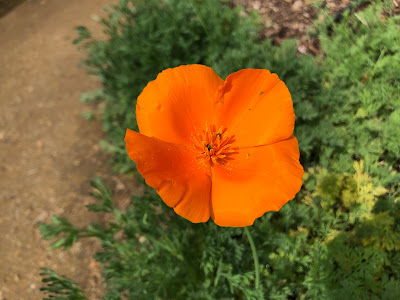
Find scores of varieties that love growing in Sacramento

|
|
The California poppy may be the most recognizable
California native plant, but there are many others that
grow well in the Sacramento region. (Photo: Kathy
Morrison)
|
Our California poppies are a reminder: March is for planting – especially California natives.
While our state flower is in bloom, other natives are just beginning to sprout new growth. Flowering shrubs and small trees such as western redbud look their best this month, too, inspiring gardeners to add them to their landscape.
Making the most of this planting window is the annual spring sale of the Sacramento Valley chapter of the California Native Plant Society. And with a pandemic-inspired twist, this spring sale is all online.
Patrons may order plants Wednesday through Sunday, March 9-13. The sale officially opens at noon Wednesday and closes at 5 p.m. Sunday.
Then, make a reservation (between 10 a.m. and 2:30 p.m.) for drive-through pick up on one of two Sundays, March 20 or March 27. The plants will be available at the chapter’s Elderberry Farms Nursery at Soil Born Farms’ American River Ranch at 2140 Chase Drive, Rancho Cordova.
Scores of varieties of water-wise California natives will be available from Achillea millefolium (yarrow) to Vitis californica (California wild grape). Shop early for best selection.
Planting California natives is a great way to support native wildlife such as bees, butterflies and birds. About 80 varieties of plants offered in this sale are considered butterfly magnets. Almost 50 attract birds while 25 specifically are hummingbird favorites.
Browse for yourself. Find details and a link to the updated sale online catalog here: https://sacvalleycnps.org//plant-sales/ .
Comments
0 comments have been posted.Sacramento Digs Gardening to your inbox.
Food in My Back Yard Series
May 6: Maintain soil moisture with mulch for garden success
April 29: What's (already) wrong with my tomato plants?
April 22: Should you stock up on fertilizer? (Yes!)
April 15: Grow culinary herbs in containers
April 8: When to plant summer vegetables
April 1: Don't be fooled by these garden myths
March 25: Fertilizer tips: How to 'feed' your vegetables for healthy growth
March 18: Time to give vegetable seedlings some more space
March 11: Ways to win the fight against weeds
March 4: Potatoes from the garden
Feb. 25: Plant a fruit tree now -- for later
Feb. 18: How to squeeze more food into less space
Feb. 11: When to plant? Consider staggering your transplants
Feb. 4: Starting in seed starting
Sites We Like
Garden Checklist for week of May 11
Make the most of the lower temperatures early in the week. We’ll be back in the 80s by Thursday.
* Plant, plant, plant! It’s prime planting season in the Sacramento area. Time to set out those tomato transplants along with peppers and eggplants. Pinch off any flowers on new transplants to make them concentrate on establishing roots instead of setting premature fruit.
* Direct-seed melons, cucumbers, summer squash, corn, radishes, pumpkins and annual herbs such as basil.
* Harvest cabbage, lettuce, peas and green onions.
* In the flower garden, direct-seed sunflowers, cosmos, salvia, zinnias, marigolds, celosia and asters. (You also can transplant seedlings for many of the same flowers.)
* Plant dahlia tubers.
* Transplant petunias, marigolds and perennial flowers such as astilbe, columbine, coneflowers, coreopsis, dahlias, rudbeckia and verbena.
* Keep an eye out for slugs, snails, earwigs and aphids that want to dine on tender new growth.
* Feed summer bloomers with a balanced fertilizer.
* For continued bloom, cut off spent flowers on roses as well as other flowering plants.
* Add mulch to the garden to maintain moisture. Mulch also cuts down on weeds. But don’t let it mound around the stems or trunks of trees or shrubs. Leave about a 6-inch-to-1-foot circle to avoid crown rot or other problems.
* Remember to weed! Pull those nasties before they set seed.
* Water early in the day and keep seedlings evenly moist.